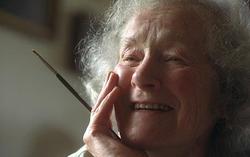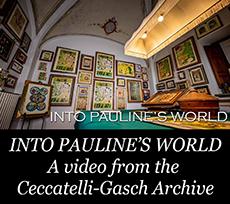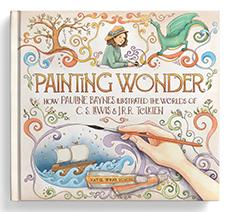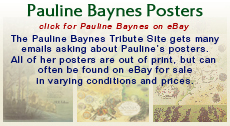
Pauline Diana Baynes was born on September 9, 1922 in Hove, East Sussex. Her earliest memories were of her childhood in India, where her father was with the Indian Civil Service as a commissioner at Agra. Summers were spent at the hill station of Mussoorie in the northern Indian state of Uttarakhand, the sights and sounds of which Pauline could still vividly recall 80 years later.
This way of life came to an end when Pauline's mother declined to follow convention and sent her daughters back to school in England on their own. She left her husband (she wrote to him that he was "free to do as he pleased") and returned home with her daughters, staying with friends during term-time and in Swiss hotels for the holidays.
Sadly, neither her mother's solicitude nor the company of her adored elder sister, Angela, prevented Pauline from being unhappy. For the rest of her life she was to be haunted by memories of the misery of being abruptly parted from her Indian ayah (and from the family's pet monkey, who was trained to take tiffin at the tea table), and of crying herself to sleep on the voyage home. Trying schooldays at a convent followed, where strict, unsympathetic nuns mocked her outlandish imagination, her handmade, eccentric clothes and her ability to speak Hindi. She was only comforted when she learned that her experiences were similar to those of Rudyard Kipling, whose work she greatly admired.
She then spent a year at the Beaufront girls' boarding school, Camberley. Her favourite subject there, she once recalled, was art, "because it was easy". But, her life improved immeasurably when, aged 15, she spent two terms studying design at the Farnham School of Art, before following her sister to the Slade, then in Oxford. From the start she knew that she wanted to illustrate children's books.
Although she later confessed to having wasted her time at the Slade "on coffee and parties" and left without any qualifications, she had innate talent, the determination to hone her craft, a willingness to learn and an openness to inspiration. Her influences were, she said, "firstly, a brilliant elder sister" followed by a catalogue of artists whose work she studied and admired: Edmund Dulac, Rex Whistler, Arthur Rackham, Gustave Doré, the Punch artists R.S. Sherriffs and E.H. Shepard (who would become Pauline Baynes's friend and mentor) and a particular graphic hero, the French illustrator Jacque-Marie-Gaston Onfray de Bréville, who signed his work with the pseudonymous acronym "Job".
In 1940, following the outbreak of the Second World War, the Woman's Voluntary Service despatched the two Baynes sisters to work as assistant model-makers with the Royal Engineers' Camouflage Development and Training Centre based in Farnham Castle, and later drawing maps and naval charts for the Admiralty in Bath.
It was through a fellow worker, Powell Perry, who belonged to a family firm that printed children's picture books, that Baynes got her first commission, illustrating a book entitled Question Mark.
In 1942, Baynes was drawing charts for the Admiralty Hydrographic Department in Bath, whilst illustrating more children's books, this time for Country Life. Her début as both writer and illustrator, Victoria and the Golden Bird, appeared in 1948 and, in the same year came the commission that was to establish her reputation when a portfolio of artwork submitted to the publisher George Allen & Unwin was shown to J.R.R. Tolkien, the author of The Hobbit.
Tolkien had written Farmer Giles of Ham, a humorous novella about dragons and knight-errantry set in a faux-medieval period, but was dissatisfied with the work of the artist who had been chosen as illustrator. Baynes's work caught Tolkien's eye and she got the job, creating a lively set of pictures that wittily pastiche the look of illuminated medieval manuscripts. So perfectly did Baynes capture the essence of Tolkien's tale that he declared them to be "more than illustrations, they are a collateral theme". He also delighted in reporting that friends had said that her pictures had succeeded in reducing his text to "a commentary on the drawings".
Baynes would later illustrate many authentic medieval stories, all of which show her painstaking research into the detailing of period costume and architecture, and her passion for recreating the texture and fabric of daily life in different ages. Her greatest triumph in this genre were her almost 600 illustrations embellishing the margins of Grant Uden's A Dictionary of Chivalry (1968), a two-year labour that deservedly earned her the coveted Kate Greenaway Medal.
Tolkien's Farmer Giles was the beginning of a long friendship and repeated collaboration between author and artist with Baynes decorating Tolkien's subsequent books The Adventures of Tom Bombadil and Smith of Wootton Major and, posthumously, Leaf by Niggle and Bilbo's Last Song.
Tolkien had expressed the hope that Baynes would illustrate The Lord of the Rings, but the book grew into a gargantuan project that rendered that plan impractical. Nevertheless, she created immaculately drawn and exquisitely coloured versions of the author's maps of the lands travelled by Bilbo and Frodo Baggins and her slipcase design for the three volumes of Tolkien's epic was later adapted as a cover for the original one-volume paperback edition – an indispensable prop of the Sixties generation – with its evocative landscape of Middle-earth viewed through a doorway of yellow, over-arching trees.
It was Baynes' collaboration with Tolkien that led to her subsequent association with the septet of children's novels written by Tolkien's friend C.S. Lewis and published annually between 1950 and 1956: The Lion, the Witch and the Wardrobe, Prince Caspian, The Voyage of the 'Dawn Treader', The Silver Chair, The Horse and His Boy, The Magician's Nephew and The Last Battle.
Baynes returned to these stories several times, creating memorable cover designs for the Puffin paperbacks; producing new colour illustrations for The Land of Narnia (1989), a large-format edition of The Lion, the Witch and the Wardrobe (1991) and, three years later, A Book of Narnians. Then, in 1998, she subtly water-coloured all the original line illustrations in all seven volumes to meet the demands of a generation no longer content with black-and-white pictures.
"Met C.S. Lewis. Came home. Made rock cakes." That's how Baynes's diary recorded one of only two meetings she ever had with the author whose work she so memorably pictured and with whom she is now inextricably linked. The relationship between author and artist was cordial and professional but without the depth of respect and affection existing between Baynes and Tolkien. For readers of the books, however, the pictures were, and have remained, an integral part of the whole culture of Narnia – not even displaced by the big-screen dazzlements of the recent movie versions.
In 1961, Baynes met Fritz Gasch, a German ex-prisoner of war who was working locally as a dog's-meat man. A whirlwind courtship led to their marriage. They were a close couple and Fritz became especially friendly with Tolkien and Shepard, with whom he traded war memories. Fritz's sudden death, in 1988, left Baynes bereft but she poured her energies into her work and produced some of her most accomplished pieces.
Then two years later Pauline Baynes received, from out of the blue, a telephone call from a daughter of Gasch's by his first, pre-war, marriage. Following the fall of the Iron Curtain, the daughter had discovered that her father had stayed on in England after the war and that he had remarried. She had never met him, but was delighted to find the woman who had loved him; and so in old age Pauline Baynes found that she had a family after all. "It was," she said, "like something magical coming back at me through a wardrobe."
She continued to work every day at a desk positioned beneath a window that looked out over the garden her husband had created for her, and in which his ashes were scattered. The desk would be strewn with half-empty gouache tubes and rows of well-worn pens and brushes; Handel's music would be playing in the background; and Pauline Baynes's dogs, including her 3rd rottweiler (all were named Bertha!) would be lying at her feet.
Pauline died in August 2008, still working on projects, including a highly decorative version of the Koran. She was also half-way through a very colourful Aesop's Fables. She remains one of the most influential illustrators of the twentieth century.
Pauline Baynes Biography information courtesy UK publishers The Independent (Brian Sibley), The Guardian, The Telegraph (Charlotte Cory) and ThisIsAnnouncements.co.uk, and Pauline friends Brian Sibley, John Coulth, Martin Springett and Peter Thorpe.






